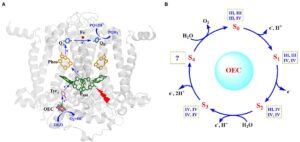What is the Oxygen Evolving Complex and how does it work?
The Oxygen Evolving Complex (OE-C) is a cluster of manganese and calcium ions found in the photosystem II of plants and algae. It plays a crucial role in photosynthesis by catalyzing the splitting of water molecules into oxygen, protons, and electrons, providing the necessary oxygen for life on Earth.
The electronic structure of the Oxygen Evolving Complex (OE-C) is a crucial factor in understanding its function in photosynthesis. High-quality initial guesses of the QM layer electronic structure are required for MOD-QM/MM computations of the O-EC of PSII. These include a proper description of spin states in the O-EC cluster as directly compared to spectroscopic measurements. Ligand field theory, as implemented in Jaguar 5, has been used to obtain these initial guesses. Recent advancements have led to the development of artificial Mn4 XO4-clusters that closely mimic both the geometric structure and crystal structure of the O-EC, as well as its redox property. These developments have provided valuable insights into the electronic structure and function of the O-EC in photosynthesis.
Introduction
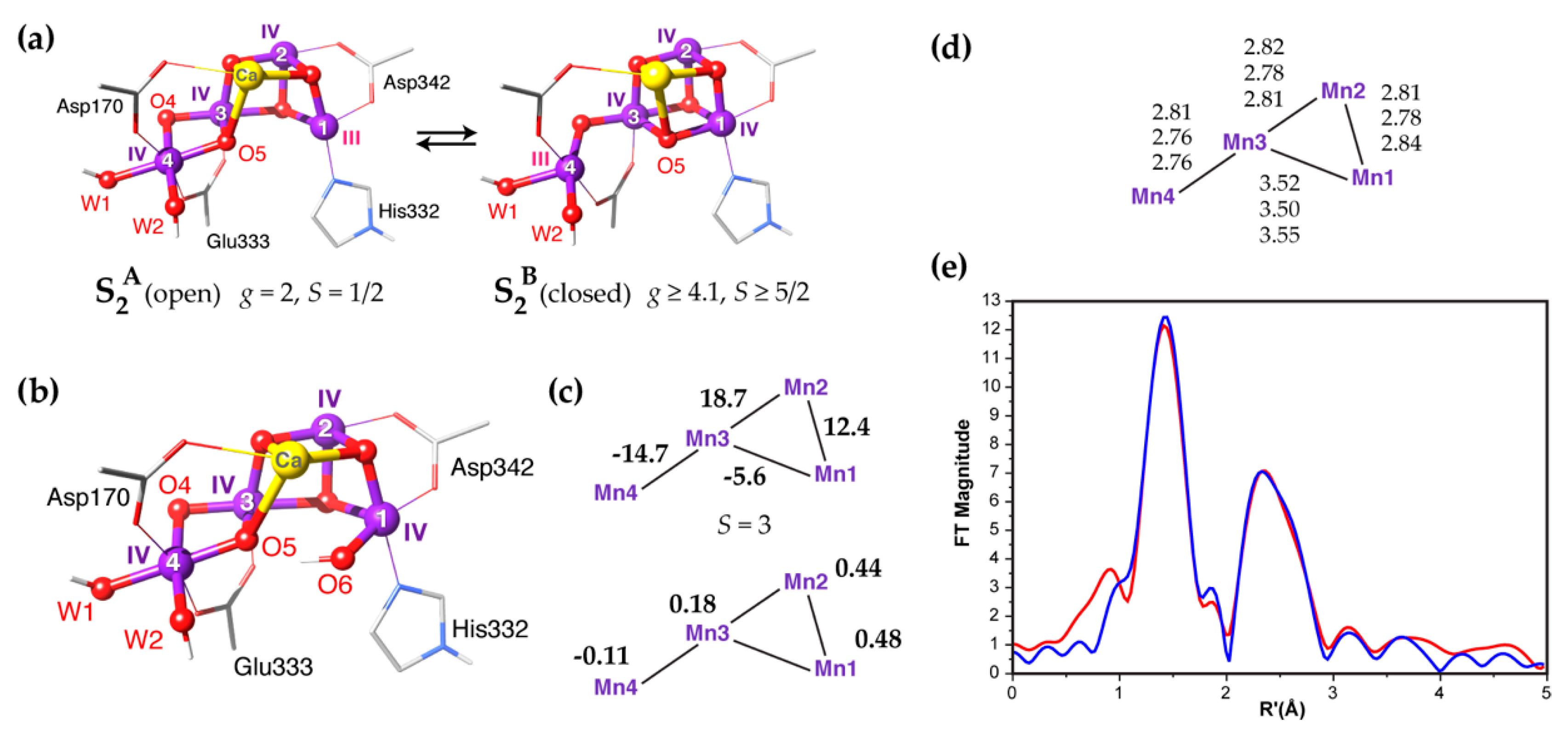
In plants, algae, and some bacteria, photosynthesis is an essential biological activity that transforms light energy into chemical energy in the form of glucose. Energy conversion, the synthesis of oxygen, the fixing of carbon dioxide, ecological stability, and human agriculture all depend on it. Sunlight is converted by photosynthesis into organic compounds that are valuable and a component of the food chain. It releases oxygen, which is necessary for both atmospheric oxygen preservation and aerobic life. Additionally, photosynthesis aids in the absorption of carbon dioxide, which lowers greenhouse gas emissions and modifies Earth’s temperature. It is essential to human agriculture because it promotes the growth of fruits, vegetables, and crops.
An essential component of photosynthesis is the oxygen-evolving complex (OE-C), which produces oxygen from water molecules in the thylakoid membranes of chloroplasts. It divides water molecules into protons, electrons, and oxygen by catalysis. It is the primary mechanism of photosystem II (PSII), the first protein complex involved in photosynthesis that is dependent on light. In addition to producing oxygen, the O-EC keeps the electron flow going for the production of ATP and NADPH. For the sake of renewable energy applications, it is very promising to comprehend the structure and workings of the O-EC.
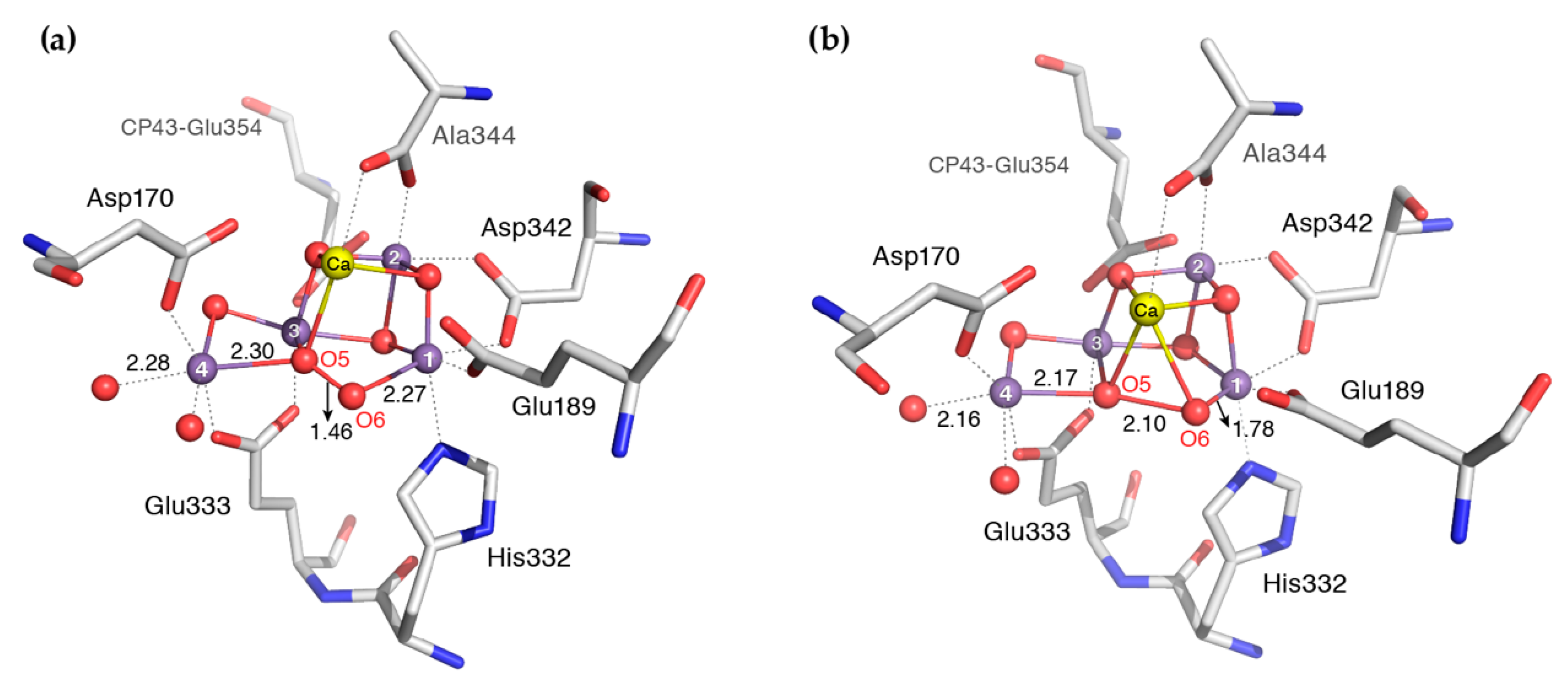
Understanding Photosystem II and the OE-C
A protein structure found in chloroplasts called Photosystem II (PSII) is essential to the light-dependent processes of photosynthesis. It moves electrons within pigments, such as chlorophyll molecules, by absorbing light energy from them. Through electron carriers, excited electrons are transported, progressively losing energy. In addition, PSII catalyses the oxidation of water and the release of O, generating a proton gradient that ATP synthase uses to make ATP, the energy unit of the cell. Light-dependent processes involving PSII are essential for plant development and the continuation of life in the biosphere.
The O-evolving complex (OE-C) is a crucial component of oxygenic photosynthesis, which enables the conversion of solar energy into chemical energy in living organisms. The O-EC is responsible for catalyzing the oxidation of water into O, protons and electrons. The inorganic core of the O-EC comprises four Mn and one Ca ions, Mn4 CaO5. The O produced by photosynthesis has been taken up again by respiration since the Archean era. Research on the photosystem II manganese complex has shown that there are eight steps preceding O-O bond formation in oxygenic photosynthesis.
The O Evolving Complex (OE-C) is a cluster of metal ions in the photosystem II (PSII) of plants and algae. It plays an important role in the production of O during photosynthesis. The O-EC undergoes a series of redox reactions that involve the transfer of electrons and metal ion movement. This metal ion movement is then followed by O insertion, which ultimately leads to the release of molecular O gas. Metal ion-containing compounds such as metal oxo compounds can develop electrophilic character at O because of π-donation from O to a metal ion in a high oxidation state, making them crucial for efficient electron donation in various chemical reactions and catalysis.
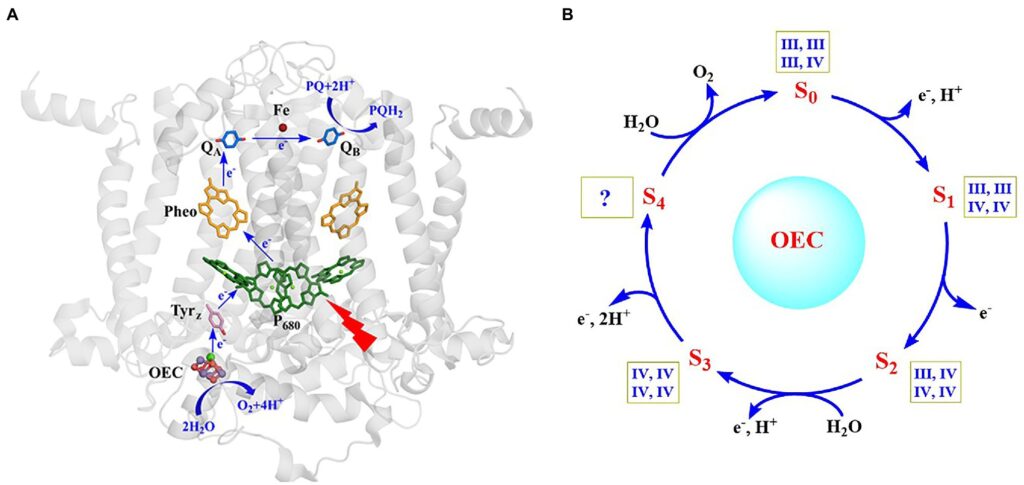 One essential part of Photosystem II (PSII) that helps with the light-dependent processes of photosynthesis is the Oxygen Evolving Complex (OE-C). It is found inside the chloroplasts’ thylakoid membranes and is essential to the process by which water molecules oxidise to produce molecular O, protons, and electrons. Complex interactions and electron extraction are made possible by the manganese-calcium cluster that makes up the structure of the O-EC. It also functions as an electron source, giving the photosynthetic electron transport chain a steady supply of electrons. The production of ATP and NADPH, two vital energy carriers for photosynthesis, is indirectly aided by the O-EC.
One essential part of Photosystem II (PSII) that helps with the light-dependent processes of photosynthesis is the Oxygen Evolving Complex (OE-C). It is found inside the chloroplasts’ thylakoid membranes and is essential to the process by which water molecules oxidise to produce molecular O, protons, and electrons. Complex interactions and electron extraction are made possible by the manganese-calcium cluster that makes up the structure of the O-EC. It also functions as an electron source, giving the photosynthetic electron transport chain a steady supply of electrons. The production of ATP and NADPH, two vital energy carriers for photosynthesis, is indirectly aided by the O-EC.
The O-evolving complex (OE-C) is a protein complex found in plants that is responsible for the process of photosynthesis. Understanding the mechanism of OE-C is crucial because it can help scientists design artificial photosynthetic systems that can produce sustainable energy. Scientists have used electron paramagnetic resonance (EPR) and X-ray spectroscopy to study the O-EC, but much about its role and function remains unknown. The presence of Ca+2, Cl−1, and membrane proteins surrounding the metal cluster also adds to the complexity of studying this fascinating protein complex.
The Oxygen Evolving Complex (OE-C) is a cluster of metal ions found in plants that is responsible for the evolution of O during photosynthesis. The ground state of the O-EC contains four manganese ions and one calcium ion, and it undergoes a series of oxidation reactions to release O. The ground state of the Mn4 unit produces a multiline EPR signal from the S0 state which is wider than the S2 state signal. Four photons must be absorbed to excite P680 four times, and each time an electron from Tyr161 replaces the ground state electron in P680, leaving behind a hole. The charges then produced O2 and returned to the ground state, which was stable in the dark.
Wiki Page: Click here
An essential part of photosynthesis’ water oxidation process, the Oxygen Evolving Complex (O-EC) facilitates the release of protons, electrons, and molecular oxygen. Water molecules are more easily separated into oxygen, protons, and electrons thanks to the catalytic action of the O-EC. The complex configuration of manganese, calcium, and oxygen atoms in the Mn4CaO5 cluster facilitates oxidation-reduction processes that yield O. Terrestrial and aquatic ecosystems, as well as aerobic living forms, depend on the oxygen produced during this process. The O-EC transforms light energy into chemical energy, which permits the synthesis of molecules rich in energy. It also acts as an electron source for the electron transport system used by photosynthesis.

The Oxygen Evolving Complex (O-EC) is a protein that contains side chains of histidine, aspartate, glutamate, and alanine. These side chains act like a multi-dentate chelator, binding to the metal ions in the complex through multiple donor atoms. The QM/MM interface of the O-EC can be defined by breaking the C-C bonds of these side chains in the amino acid residues mentioned above. Understanding the role of side chains in the O-EC is important for understanding its function in photosynthesis and may lead to new insights into how to improve photosynthesis in plants.
The Oxygen Evolving Complex (O-EC) is a vital component of the photosynthetic process in plants, algae, and cyanobacteria. It is responsible for splitting water into oxygen and hydrogen ions, which are then used to create energy. The O-EC is composed of four manganese atoms and one calcium atom held together by a triple junction. The triple junction provides stability to the complex and allows for efficient electron transfer during the photosynthetic process. Understanding the structure and function of the O-EC has important implications for developing sustainable energy sources inspired by nature.
The molecular structure of the Oxygen Evolving Complex (O-EC) is a fascinating subject in the field of biochemistry. It consists of four manganese atoms and one calcium atom, arranged in a cubane-like structure. The O-EC plays a crucial role in photosynthesis by catalyzing the oxidation of water to molecular oxygen. The molecular structure of the O-EC has been extensively studied using various techniques such as X-ray crystallography, electron paramagnetic resonance spectroscopy, and computational modeling. These studies have provided valuable insights into the mechanism of water oxidation and the role of each metal ion in this process.

The Oxygen Evolving Complex (O-EC) is a cluster of manganese and oxygen atoms found in plants that is responsible for generating oxygen through the process of photosynthesis. The total energy required for this process is high, and researchers have been studying the O-EC to better understand its structure and function. By analyzing the QM layer in various spin states and comparing structural and electronic features to experimental data from high-resolution spectroscopy, scientists can gain insights into the total energy required for oxygen evolution and potentially develop more efficient methods for producing oxygen.
https://scholar.google.com/scholar_lookup
https://scifinder.cas.org/scifinder/view/link_v1/reference.jsf
Recent use of molecular dynamics in the analysis of oxygen evolving complex has provided valuable insights into the process of water oxidation. A recent study by Kuroda et al. (2021) used molecular dynamics and saturation mutagenesis to analyze water oxidation, which highlighted the power of combining theory and experiment. The study identified key residues that play a crucial role in connecting this chain to bulk water, such as PsbA-Arg334, PsbD-Glu302, and PsbD-Glu323. This recent use of molecular dynamics has helped increase our understanding of how the oxygen evolving complex works by identifying potential pathways for water oxidation.
The oxygen evolving complex (O-EC) is responsible for the light-driven water oxidation reaction that occurs at the donor side of photosystem II (PSII). The O-EC contains four manganese ions and a calcium ion, which work together to catalyze the water-splitting reaction. This process generates molecular oxygen and provides electrons that are transported through the electron transport chain to power cellular processes. The electron donor side of PSII is essential for efficient photosynthesis and plays a crucial role in maintaining the Earth’s oxygen levels.
https://api.semanticscholar.org/CorpusID:31914925
The Kok cycle is a process that illustrates the various steps involved in oxygen evolution in the oxygen-evolving complex (O-EC) of photosystem II (PSII). The cycle involves successive absorption of photons during water splitting, resulting in electron and proton release. The cycle is named after its discoverer, Yasuhiro Kok. The cycle comprises several steps, including the oxidation of Mn(II) to Mn(III), formation of an S1 state, oxidation of Mn(III) to Mn(IV), formation of an S2 state, and so on until the formation of an S4 state where O2 evolves. The Kok cycle provides a detailed understanding of the mechanism behind oxygen evolution in PSII.
The Oxygen Evolving Complex (O-EC) is a critical component of photosystem II (PSII) in plants, algae, and cyanobacteria. It is responsible for light absorption and the conversion of light energy into chemical energy through the process of photosynthesis. The O-EC contains a cluster of manganese ions that act as a catalyst to split water molecules into oxygen gas, protons, and electrons. The light absorption by the O-EC is an essential step in this process, as it provides the energy required for the oxidation of water. This mechanism enables plants to produce oxygen and store energy from light in the form of ATP and NADPH.
The Oxygen Evolving Complex (O-EC) is a crucial component of photosystem II in plants and algae, responsible for splitting water molecules into oxygen and protons. The O-EC undergoes different states known as S states during this process, with each state representing a different stage in the reaction cycle. These states have been studied using various techniques such as vibrational spectroscopy and X-ray absorption spectroscopy, revealing important information about their structural changes and charge equilibria. Understanding the S states of the OE-C is essential for developing artificial photosynthesis systems that can mimic natural photosynthesis and provide sustainable energy solutions.
The oxygen-evolving complex (O-EC) plays a crucial role in the process of photosynthesis, and its fine structure has been extensively studied using various techniques such as extended X-ray absorption fine structure (EXAFS). The O-EC is composed of a cluster of manganese, calcium, and oxygen atoms that are held in place by side chains of amino acids. Despite some ambiguity due to distortion during X-ray analysis, the fine structure of the O-EC has been revealed through EXAFS and other methods. Understanding the structure and function of the O-EC can lead to advancements in renewable energy production.
The oxygen evolving complex (OE-C) is a manganese cluster in photosystem II that plays a crucial role in the light-driven oxidation of water to molecular oxygen. An important aspect of the O-EC cluster is the antiferromagnetic coupling between manganese centers. This allows for efficient electron transfer and prevents unwanted side reactions. The O-EC has been extensively studied using various computational methods, including broken-symmetry states and density functional theory (DFT), to understand its electronic structure and reaction mechanism. Recent X-ray diffraction models have provided new insights into the structure and function of this complex system, particularly in the S1 Mn4(IV,III,IV,III) state where Ca2+ is bridged to manganese centers by carboxylate moieties.
https://api.semanticscholar.org/CorpusID:205224374
The Oxygen Evolving Complex is a critical component of photosynthesis that helps to release oxygen from water molecules. Proton deposition is an essential step in this process, and it occurs through multiple pathways in the lumen. The proton release from PsbA-Glu65 is well understood, but the exact proton deposition pathways may involve other parts of the complex such as PsbD-Glu312 and PsbA-Arg334. Further research on these proton transfer pathways can help us better understand the intricate mechanisms involved in photosynthesis.
The Oxygen Evolving Complex (OE-C) is a crucial component of photosynthesis. It consists of manganese ions and calcium atoms held together by a protein matrix. To study the O-EC, stainless steel electrodes are commonly used in experiments to measure the rate of oxygen production during photosynthesis. The stainless steel is non-reactive and does not interfere with the reaction taking place. Understanding the O-EC and how it works can help improve our understanding of photosynthesis and potentially lead to new technologies for renewable energy production.
https://creativecommons.org/licenses/by/3.0/
The Oxygen Evolving Complex (OE-C) is a group of proteins in photosynthetic organisms responsible for the evolution of oxygen from water. The evolution rate of oxygen is affected by mutations in the O-EC, such as the PsbA-H190Y and PsbA-H190F mutations. While the former leads to a modest decrease in O2 evolution rate, the latter completely eliminates water oxidation, resulting in a sharp decline in the core PSII subunits. Understanding these mutations and their effects on the evolution rate of oxygen is crucial in studying photosynthesis and its potential applications.
https://pubmed.ncbi.nlm.nih.gov/24816273
The Oxygen Evolving Complex (O-EC) is an essential component in photosynthesis, the process by which plants produce food from sunlight. It is responsible for splitting water into oxygen and hydrogen ions, which are used to create energy. Scientists have been studying the O-EC to understand how it works and develop new technologies that mimic its function. One such technology is the artificial leaf, which uses ordinary water and sunlight to produce streams of bubbles containing oxygen and hydrogen. This innovative device is made from inexpensive materials like silicon, cobalt, and nickel, making it a promising solution for sustainable energy production.
The Oxygen Evolving Complex (O-EC) is a cluster of metal ions and protein molecules that play a critical role in the process of photosynthesis. The resulting structure of the O-EC has been studied extensively, revealing its complex and intricate nature. Recent research has shown that the hydration shell around the O-EC contains several exchangeable deuterons near the Mn cluster in the S0, S1, and S2 states. These findings provide important insights into the structure and function of this essential component of photosynthesis.
https://pubmed.ncbi.nlm.nih.gov/28921879
The oxygen-evolving complex (O-EC) is a critical component of photosynthesis, responsible for producing oxygen from water molecules. It has been found in green algae and plants, with variations in the amino acid residues at certain positions. While cyanobacteria often have histidine residues in these positions, green algae and plants tend to have lysine residues instead. Understanding the O-EC and its variations can provide insight into the evolution and function of photosynthesis across different organisms.
The Oxygen Evolving Complex is a cluster of proteins found in photosynthetic organisms that is responsible for generating oxygen during the light-dependent reactions of photosynthesis. It contains four manganese atoms and one calcium atom, which work together in a series of redox reactions to split water molecules and release oxygen gas. The process is triggered by light flashes, which provide the energy needed to drive the reaction forward. Understanding the mechanisms behind the Oxygen Evolving Complex, including the three extrinsic proteins, is critical for developing new technologies that can harness the power of sunlight to generate clean energy.
https://pubmed.ncbi.nlm.nih.gov/5456273
The Oxygen Evolving Complex is a cluster of metal ions and associated molecules found in the photosystem II complex. It is responsible for the oxidation of water to oxygen during the light-dependent reactions of photosynthesis. The mechanism of this process is still under investigation, but studies have suggested that at least one water molecule is bound to Ca2+ based on 18O isotope exchange measurements, indicating the presence of O isotope exchange. This exchange is an important indicator for understanding the catalytic mechanism and efficiency of O-EC.
The Oxygen Evolving Complex (OE-C) is essential for photosynthesis. It consists of a cluster of proteins that are responsible for evolving oxygen from water molecules during the light-dependent reactions of photosynthesis. PSII activity, or activity of Photosystem II, is crucial for O-EC activity and plays a major role in the process of oxygen evolution. Studies have shown that certain compounds like GB can protect PSII activity and maintain membrane integrity, leading to improved plant growth and yield. However, decreases in PSII activity can result in over-reduction in the electron transport chain and photooxidation.
https://pubmed.ncbi.nlm.nih.gov/28219079
Oxygen Evolving Complex (OE-C) is a cluster of proteins that plays a crucial role in photosynthesis by producing oxygen. Research on the OE-C has been aided by various spectroscopy techniques, including epr spectroscopy. This technique has helped identify and characterize different states of the O-EC, such as the high-spin and low-spin forms, based on their distinct EPR signals. Epr spectroscopy has also been used to detect changes in the yield of radicals like YZ•, which can provide insights into how the O-EC functions and responds to external stimuli.
The Oxygen Evolving Complex (OE-C) is a vital component of photosynthetic activity in plants. O-EC is responsible for the production of oxygen gas during photosynthesis. However, disruptions in OE-C activity can lead to a decrease in photosynthetic activity and electron transport rates. Photodamaged PSII undergoes a well-regulated, multistep repair process to replace the damaged D1 protein, involving detachment of Mn from OE-C. It is essential to maintain the proper functioning of O-EC for the efficient photosynthetic activity of plants.
Structure of the Oxygen Evolving Complex
An essential part of photosynthesis is the Oxygen Evolving Complex (O-EC), which is mostly made up of oxygen (O), calcium (Ca), and manganese (Mn). The cubane-like Mn4CaO5 cluster helps with electron transport during the water-splitting process. Because of its structure, protons and electrons may travel in unison, and the catalytic site is formed when its exact location is surrounded by oxygen atoms. During the manganese oxidation cycle, the O-EC dynamically alters, moving through intermediate states as protons and electrons are exchanged. Because of its dynamic character, the O-EC is able to continually harvest electrons from water, guaranteeing a constant supply of electrons that are necessary for photosynthesis.
During photosynthesis, the Oxygen Evolving Complex (O-EC), specifically the Mn4CaO5 cluster in Photosystem II (PSII), is essential for the oxidation of water. To comprehend its complex architecture and catalytic function, scientists have created theoretical models and representations based on experimental data and computer simulations. These models consist of scientific graphics, computer simulations, schematic diagrams, and crystallographic models. However, the tiny scale, dynamic behavior’s, and experimental technique constraints of the O-EC make it difficult to visualize owing to its complexity. At the reaction center of PSII is the oxygen evolving center (O-EC), which is responsible for oxidizing 2 H2 O to O2 (Equation 1 above). Researchers and educators can better grasp the spatial arrangement of atoms, the functions of particular ions and oxygen atoms, and the general catalytic process involved in water oxidation by using visualizations, which are useful tools.
The structure and function of the Oxygen Evolving Complex (OE-C) in water oxidation within Photosystem II of photosynthesis depend heavily on the Mn4CaO5 cluster. The processes of electron transport, catalysis, structural stability, and control all depend on manganese and calcium ions. Together, they provide an atmosphere that is favorable for effective water oxidation, illustrating how these ions work in concert to support photosynthesis in the natural world.
Mechanism of Action
The Oxygen Evolving Complex (O-EC) in Photosystem II catalyzes the oxidation of water during photosynthesis. This process involves the binding of water, the sequential extraction of electrons, the formation of reactive intermediates, the formation of oxygen-oxygen bonds, and the release of molecular oxygen. Although research on the precise process is still underway, a knowledge of the OE-C’s function can spur the development of renewable energy devices and increase solar energy harvesting efficiency.
Water oxidation during photosynthesis is catalyzed by the Oxygen–Evolving Complex (OE-C) in Photosystem II (PSII). The O-EC travels through a number of intermediate phases, one of which is the steady but passive S0 state. When photons are absorbed, the O-EC transitions between the S1, S2, S3, and S4 states, each of which involves water oxidation and activation of psii centers.

Reactive oxygen species and high-energy intermediates are created during these transitions and are essential for the synthesis of oxygen-oxygen bonds and electron transfer. When the O-EC makes an oxygen link between two O atoms in the S4 state, a species resembling peroxide is produced. The O-EC is then returned to its lower oxidation states by the emission of molecular O (O2) in the S states. Comprehending these transitional phases is essential to comprehending the oxidation of water during photosynthesis and creating artificial systems for the generation of sustainable energy.
Also read: Elevate Your Writing: The Top 14 AI Paraphrase Tools Redefining Creativity and SEO Excellence!
The Oxygen–Evolving Complex (OE-C) in Photosystem II (PSII) of photosynthesis is responsible for the water-splitting process, which releases molecular oxygen, protons, and electrons as required byproducts. Apart from being necessary for the survival and breathing of aerobic organisms, oxygen also contributes to the stability of atmospheric oxygen concentrations.
The cell’s energy currency, ATP synthase, is powered by a proton gradient created when protons are discharged into the thylakoid lumen. The photosynthetic electron transport chain produces electrons, which fuel the creation of molecules high in energy such as ATP and NADPH. These molecules aid in the Calvin cycle and the transformation of carbon dioxide into carbohydrates. The creation of energy, the respiration of cells, and the transformation of light energy into chemical energy all depend on these byproducts.
Significance and Applications
An essential part of photosynthesis, the Oxygen-Evolving Complex (OE-C) is vital to the process. Understanding the O-EC can help one better understand electron transport, the process of water oxidation, and photosynthesis efficiency. It also provides information on biomimicry and technology, including how to create clean energy production catalysts and sustainable energy systems. Increased agricultural yields and increased food security may result from the OE-C’s effective use of solar energy. Additionally, it can assist in addressing environmental issues including mitigating climate change and developing bioinspired solutions. Comprehending the intricacies of the Oxygen can result in revolutionary uses in the fields of energy, agriculture, materials research, and environmental preservation.
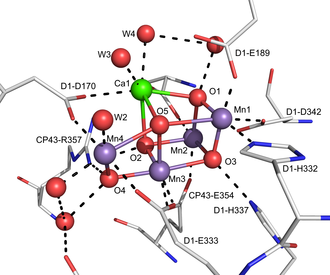 Photosystem II (PSII) contains the Oxygen-Evolving Complex (OE-C), which presents opportunities for artificial photosynthesis and renewable energy technologies. It may be applied to artificial leaf technology, solar fuel generation, and solar-to-chemical energy conversion. But there are obstacles, including creating effective catalysts and enhancing scalability and efficiency. The use of O-EC principles might enhance energy availability in impoverished regions and help achieve carbon neutrality in the future.
Photosystem II (PSII) contains the Oxygen-Evolving Complex (OE-C), which presents opportunities for artificial photosynthesis and renewable energy technologies. It may be applied to artificial leaf technology, solar fuel generation, and solar-to-chemical energy conversion. But there are obstacles, including creating effective catalysts and enhancing scalability and efficiency. The use of O-EC principles might enhance energy availability in impoverished regions and help achieve carbon neutrality in the future.
OE-C Research and Future Prospects
Multidisciplinary methods, including as X-ray crystallography, spectroscopic techniques, transient kinetic investigations, computer modelling, and mutagenesis studies, are used in research on the Oxygen Evolving Complex (O-EC) inside Photosystem II (PSII). The results have application in technology related to renewable energy and artificial photosynthesis. The mechanism of O-EC, structural dynamics, and its useful applications in the fields of energy, catalysis, and environmental sciences at room temperature are among the future avenues that will be explored.
The Oxygen Evolving Complex (OE-C) is a protein complex in photosystem II that catalyzes the water-splitting reaction, releasing oxygen and generating electrons for the photosynthetic electron transport chain. The O-EC consists of a cluster of four manganese ions and one calcium ion, coordinated by amino acid residues on the protein subunits. A suitable bridge is formed between the special pair and the O-EC through the Tyr-His pair, which stabilizes the YZ • radical and oxidizes the O-EC, advancing its S-state. This process helps to generate oxygen as a byproduct of photosynthesis, making it an important component in sustaining life on Earth.
Studies on the Oxygen-Evolving Complex (OE-C) have the potential to advance science in a number of fields. Improvements in water oxidation observations, higher-resolution structures, and better catalyst design may result from developments in imaging methods, time-resolved spectroscopy, computer modelling, and mechanistic knowledge. Additionally, photoelectrochemical devices, bioinspired catalysts, and sustainable energy sources might result from O-EC research. By facilitating effective carbon collection and utilisation through artificial photosynthesis, this may also assist ameliorate the effects of climate change.
Conclusion
An essential part of photosynthesis is the Oxygen-Evolving Complex (OE-C), which transforms light energy into chemical energy. It supports life and propels developments in biochemistry, materials science, renewable energy, and environmental preservation. It is involved in water oxidation, electron transport, and energy transformation. The insights provided by O-EC have the potential to advance sustainable energy and artificial photosynthesis technology.

Research on the Oxygen-Evolving Complex (OE-C) and photosynthesis has the potential to yield ground-breaking findings that might transform scientific fields and tackle global issues. This study has the potential to solve problems related to renewable energy, environmental preservation, bioinspired technology, and interdisciplinary cooperation. It may also reveal secrets about nature and push limits. It also has educational value and leaves a long legacy, influencing science and fostering hope for a better, more sustainable future.
Photosystem II (PSII) contains the Oxygen-Evolving Complex (OE-C), which is essential for environmentally friendly technologies. It encourages the generation of clean energy, the capture and use of carbon dioxide, the application of biomimicry to environmental problems, increased photosynthetic efficiency, cross-sector cooperation, and a paradigm shift towards environmentally beneficial behaviours. The legacy of the O-EC is proof of human creativity and its capacity to protect ecosystems and future generations through its production of an oxidant with high redox potential.
